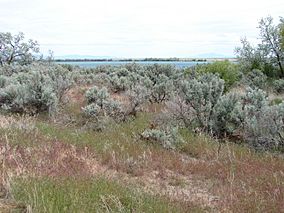Minidoka National Wildlife Refuge facts for kids
Quick facts for kids Minidoka National Wildlife Refuge |
|
|---|---|
|
IUCN Category IV (Habitat/Species Management Area)
|
|

Minidoka National Wildlife Refuge
|
|
| Location | Blaine County, Cassia County, Minidoka County, Power County, Idaho, United States |
| Nearest city | Rupert, Idaho |
| Area | 20,751 acres (83.98 km2) |
| Established | 1909 |
| Governing body | U.S. Fish and Wildlife Service |
| Website | Minidoka National Wildlife Refuge |
The Minidoka National Wildlife Refuge is a special place in south-central Idaho. It's about 12 miles (19 km) northeast of Rupert. This refuge protects about 80 miles (130 km) of shoreline around Lake Walcott. This area stretches from the Minidoka Dam for about 25 miles (40 km) upstream.
Contents
Amazing Animals of Minidoka
What animals can you spot at Minidoka? This refuge is home to many different creatures.
Mammals You Might See
You might see Mule deer near the main office. Pronghorn often roam the open, grassy areas. Many other mammals live here too. Look for beavers, cottontail rabbits, porcupines, raccoons, and coyotes. There are even thirteen different kinds of bats! Sometimes, you might even spot a cougar, bobcat, river otter, elk, or moose.
Geography and Landscapes
Minidoka National Wildlife Refuge covers about 20,751 acres (83.97 km2). About half of this area is open water and wetlands. In this dry landscape, these water sources are like an oasis. They attract many different wildlife species from miles around.
Water and Shoreline Habitats
Many animals use the bulrush and cattail plants. These plants grow along the lake's small bays. Other animals use the willows, cottonwoods, and other trees. These trees grow close to the shorelines.
Upland Areas
The rest of the refuge is made up of low, rolling uplands. These areas are covered by sagebrush, grasses, and small groups of juniper trees. You can also see scattered outcrops of basalt rock.
Climate and Weather
The climate at Minidoka is semi-arid. This means it's quite dry. The refuge gets about 11 inches (28 cm) of rain each year. Much of this rain falls as snow during the winter. Summers are hot and dry. They can have sudden rain from thunderstorms. Winters are usually mild but windy. The refuge is about 4,200 feet (1,280 m) above sea level.
Important Habitats
The undisturbed habitats at Minidoka are very important. They are critical for birds that nest in groups, like the American white pelican. They are also vital for waterfowl that are molting (shedding their feathers). You won't find habitats like these in such good condition anywhere else in southeastern Idaho.
Rocky and Sandy Areas
The uplands of the refuge have a mix of rock, sand, and shallow soil. This habitat supports many small mammals, reptiles, and invertebrates (like insects). The basalt lava flows provide homes for some of the most diverse reptiles in Idaho.
Special Species
You can find the Idaho dunes tiger beetle (Cicindela arenicola) on the refuge's sand dunes. This beetle is a species of special concern. The Utah roundmouth snail (Valvata utahensis), an endangered snail, lives in the reservoir. Both sage and sharptailed grouse also live in the refuge. Their habitat here is becoming more and more important.
A Glimpse into History
More than 100 years ago, settlers on the Oregon Trail passed just south of the refuge. Some even crossed through the refuge on a different route. Today, thousands of visitors come to Lake Walcott State Park. This park is located within the Minidoka Refuge. People come here to camp, picnic, hike, watch wildlife, hunt waterfowl, boat, and fish. Some sensitive wildlife areas are closed to visitors to protect the animals.


